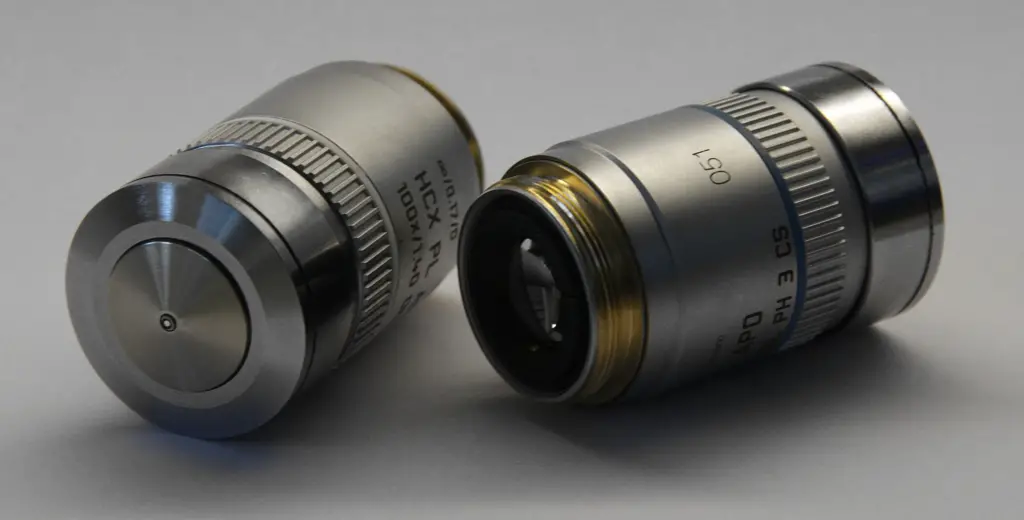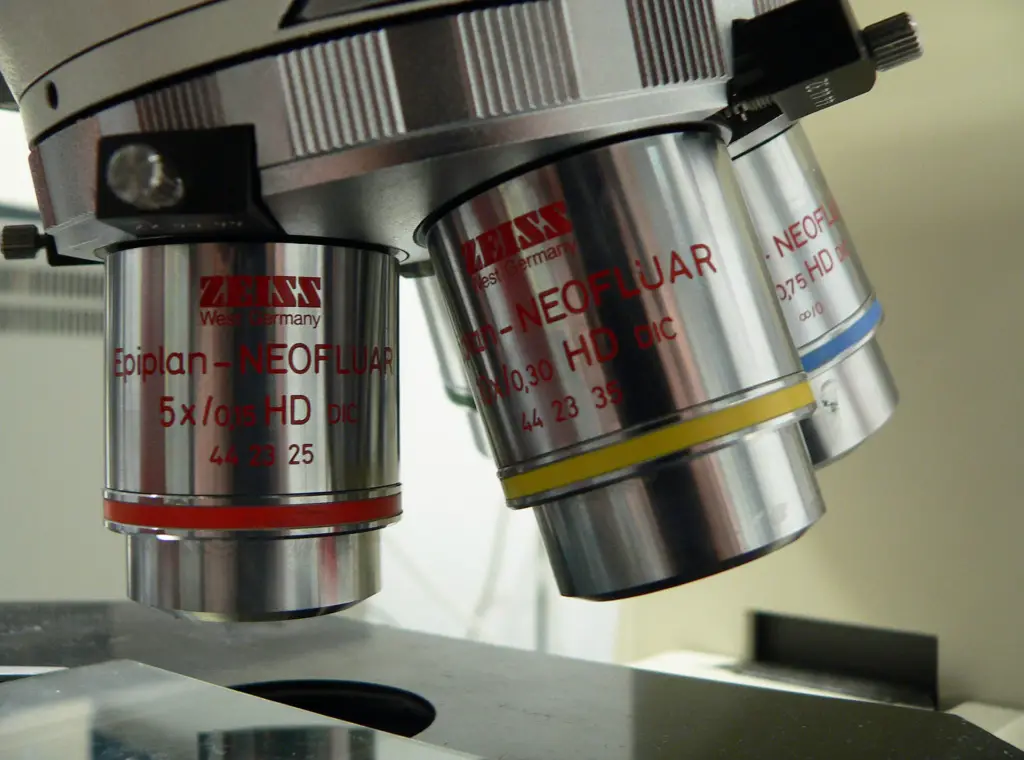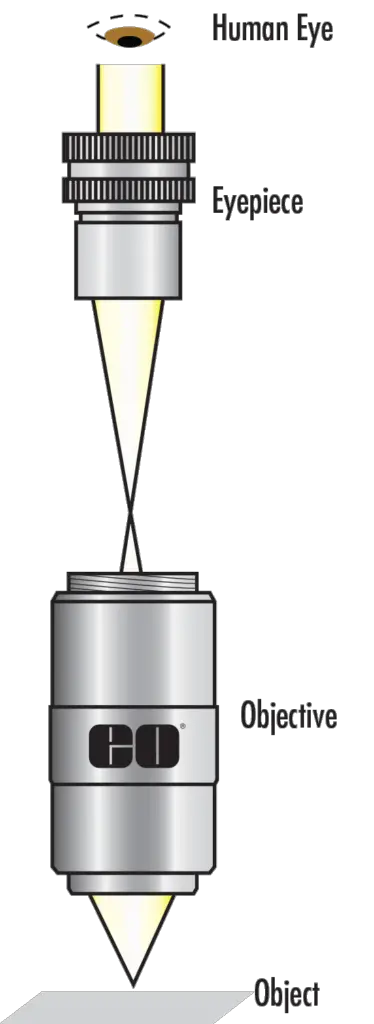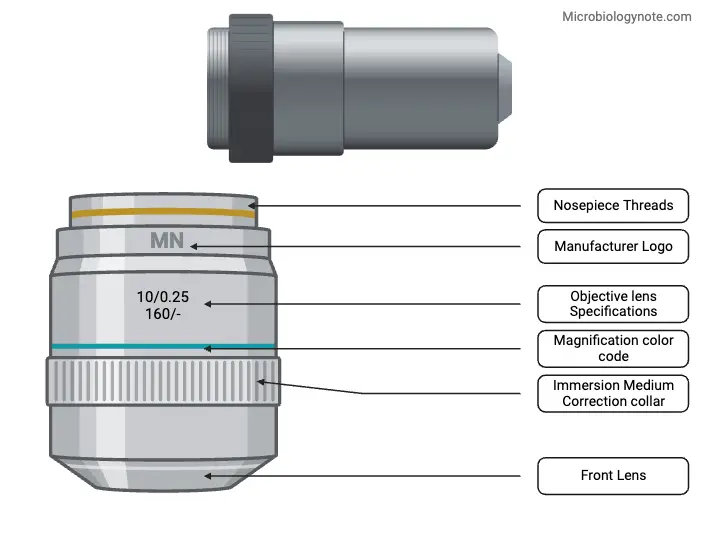Table of Contents
- Primary Function: The main role of an objective lens is to collect light and focus it to form an image. In microscopes, for instance, they magnify the specimen being observed.
- Variety of Applications: Objective lenses are used in a wide range of instruments, including microscopes, telescopes, cameras, and projectors. Each application demands specific types of objective lenses.
- Magnification Levels: They come with different magnification powers, crucial for their application. For example, microscope objective lenses can range from low (4x) to high magnification (100x or more).
- Numerical Aperture (NA): NA is a critical specification, determining an objective lens’s ability to gather light and resolve fine details.
- Aberration Correction: High-quality objective lenses are designed to minimize optical aberrations like chromatic and spherical aberrations, improving image clarity and accuracy.
- Types Based on Correction: There are various types, such as achromatic, semi-apochromatic, and apochromatic lenses, each offering different levels of aberration correction.
- Material and Coating: The materials used and coatings applied to the lens surfaces are vital for determining the quality of the image produced.
- Working Distance: This is the distance between the lens and the specimen. Higher magnification lenses typically have shorter working distances.
- Specialized Designs: Some objective lenses are designed for specific applications, like oil immersion lenses in microscopy for higher magnification and resolution.
- Maintenance and Care: Proper handling, cleaning, and storage are essential for maintaining the performance and longevity of objective lenses.
What is Objective Lens?
- The objective lens is a fundamental component in optical devices such as microscopes, telescopes, cameras, and other instruments that require magnification and detailed visualization. Its primary function is to collect light from the object being observed and focus it to form a clear, real image.
- In microscopes, the objective lens plays a crucial role. It is positioned close to the specimen being examined and is responsible for the initial magnification of the image. The quality, clarity, and detail of the image largely depend on the objective lens. Different objective lenses offer varying degrees of magnification, allowing users to observe the specimen at different scales. This versatility is essential for scientific and educational purposes, as it enables detailed examination of minute structures such as cells or microorganisms.
- Objective lenses are not limited to microscopes. They are also integral to the functioning of telescopes, where they gather light from distant objects like stars and galaxies, and focus this light to create a visible image. Similarly, in cameras, the objective lens focuses light to capture a clear photograph. Even in everyday devices like CD players, an objective lens is used to focus laser beams for reading digital information.
- The construction of an objective lens can vary. It might be a single lens or a combination of several optical elements, each designed to refine the image quality by reducing aberrations and enhancing clarity. The material and design of these lenses are crucial, as they determine the effectiveness of the light-gathering and focusing process.
- In summary, the objective lens is a vital optical element in various instruments, enabling the observation and capture of images, both microscopic and astronomic, with precision and clarity. Its ability to gather and focus light makes it indispensable in the fields of science, astronomy, photography, and digital technology.

Purpose of Objective Lenses
Objective lenses serve several key purposes in optical instruments, playing a critical role in magnification, image formation, and resolution. The primary purposes of objective lenses include:
- Magnification: One of the primary functions of an objective lens is to magnify the image of the subject being observed. In microscopes, for instance, the objective lens provides the initial magnification of the specimen. This allows for the detailed study of objects too small to be seen clearly with the naked eye, such as cells, bacteria, or material structures.
- Image Formation: The objective lens collects light from the object or specimen and focuses this light to form a real, inverted image. This image is then further magnified by other optical elements in the system, such as the eyepiece in a microscope or the camera sensor in photography.
- Resolution Enhancement: The objective lens plays a crucial role in determining the resolution of the image. A higher quality lens with a higher numerical aperture (NA) can resolve finer details in the specimen. This is particularly important in scientific and medical research where observing minute details can be crucial.
- Light Gathering: Especially in telescopes and cameras, the objective lens is responsible for gathering as much light as possible from the observed object. In telescopes, a larger objective lens can collect more light from distant stars, making them appear brighter and clearer.
- Correcting Aberrations: High-quality objective lenses are designed to minimize optical aberrations, such as chromatic and spherical aberrations. This correction is essential for producing clear, undistorted images. In advanced applications, such as in high-precision microscopes or professional photography, the quality of these corrections can significantly impact the final image quality.
- Versatility and Adaptability: Different types of objective lenses can be used for various purposes. For example, in microscopy, different lenses can be used to achieve different magnification levels or to work with specific imaging techniques like fluorescence.
- Enabling Advanced Techniques: Certain specialized objective lenses enable advanced imaging techniques. For instance, oil immersion lenses are used in microscopy to increase resolution, and long-focus lenses in telescopes allow for detailed observation of distant celestial objects.

Specification of Objective Lens
The specification of an objective lens encompasses several key parameters that define its performance and suitability for different applications. These specifications are crucial in determining how the lens will behave in terms of magnification, resolution, and image quality. Here are the main specifications commonly associated with objective lenses:
- Magnification: This indicates how much the lens can enlarge the image of the object. In microscopes, common magnifications include 4x, 10x, 40x, and 100x. Higher magnification lenses provide a closer view but have a smaller field of view.
- Numerical Aperture (NA): This is a critical specification that measures the lens’s ability to gather light and resolve fine specimen detail at a fixed object distance. Higher NA values indicate a greater ability to gather light and resolve finer details.
- Working Distance: This refers to the distance between the front lens element and the specimen when it is in focus. A longer working distance is beneficial for observing thicker specimens or when manipulation under the lens is required.
- Resolution: Resolution is the ability of a lens to distinguish between two points as separate entities. Higher resolution provides clearer, more detailed images.
- Field of View: This is the diameter of the area seen through the microscope. It typically decreases as magnification increases.
- Lens Coating: Anti-reflective coatings can be applied to lens surfaces to reduce light loss and glare, improving image brightness and contrast.
- Correction for Aberration: Objective lenses may be corrected for chromatic and spherical aberrations. These corrections improve image sharpness and color accuracy.
- Immersion Medium: Some high-magnification lenses are designed to be used with an immersion medium (like oil or water) between the lens and the specimen to increase resolution and NA.
- Mount Type: The mount type specifies how the lens attaches to the microscope, which can vary between manufacturers and models.
- Focal Length: This is the distance over which the lens focuses light. A shorter focal length corresponds to higher magnification.
How does an Objective Lens Works?
An objective lens is a critical component in optical devices like microscopes, telescopes, and cameras. It works by focusing light to create an image of the object being observed. Here’s a breakdown of how an objective lens functions in a typical microscope, which can be generalized to other optical instruments as well:

- Light Gathering: The objective lens first gathers light rays that are either emitted from or pass through the specimen. In a microscope, this light is typically directed upwards through the specimen.
- Refraction and Focus: As the light passes through the objective lens, it is refracted (bent). The lens is specifically designed to bend the light rays in such a way that they converge to form a real, inverted image of the specimen. The quality and precision of this refraction process are crucial, as they determine the clarity and resolution of the image.
- Magnification: The objective lens provides the primary magnification of the specimen. This magnification is a result of the curvature and composition of the lens. Different lenses have different magnification powers, allowing for a range of detailed views. In a microscope, this magnified image is then further enlarged by the eyepiece.
- Resolution Enhancement: The numerical aperture (NA) of the lens, a measure of its ability to gather light and resolve fine specimen details, plays a key role in determining the resolution of the image. A higher NA allows for a better resolution.
- Image Formation: The real image formed by the objective lens is typically magnified again by other optical components (like the eyepiece in a microscope) before it reaches the viewer’s eye or a camera sensor.
- Aberration Correction: High-quality objective lenses are designed to minimize optical aberrations, like chromatic and spherical aberrations. This ensures that the image is not only magnified but also clear and accurate.
In summary, an objective lens functions by gathering light from a specimen, bending the light rays to focus and magnify an image, and minimizing aberrations to produce a clear and detailed view. The effectiveness of an objective lens in performing these tasks defines the quality of the image produced in any optical instrument.
Types of Objective Lenses
A. Classification of Objective Lenses based on Magnification
Objective lenses, essential components in microscopes, are categorized based on their magnification power. This classification plays a crucial role in determining their suitability for various scientific and educational applications. Understanding the differences in magnification ranges and their specific uses is key to effectively utilizing these lenses.

- Low-Power Objective Lenses:
- Magnification Range: These lenses typically offer a magnification range of 4x to 10x.
- Typical Uses: They are ideal for observing larger specimens, providing a general overview of the sample, and identifying areas of interest for more detailed examination.
- Characteristics: Low-power lenses have a larger size and offer a lower magnification. They are characterized by a wider field of view, allowing more of the specimen to be seen at once. These lenses are generally shorter in length compared to their higher-power counterparts.
- Medium-Power Objective Lenses:
- Magnification Range: The magnification range for these lenses is between 20x to 40x.
- Typical Uses: They are used for a more detailed examination of specimens, such as studying cell structures and smaller microorganisms.
- Characteristics: These lenses are moderately sized and provide a balance between magnification and resolution. They offer more precise details compared to low-power lenses, making them suitable for intermediate-level magnification needs.
- Magnification Range: The magnification range for these lenses is between 20x to 40x.
- High-Power Objective Lenses:
- Magnification Range: High-power lenses range from 40x to 100x or more.
- Typical Uses: These lenses are used for detailed examination of tiny structures like individual cells, bacteria, or small particles.
- Characteristics: High-power lenses are smaller in size but offer higher magnification. They have a higher numerical aperture (NA), enhancing resolution and clarity. Due to the high magnification, they require careful focusing and handling.
- Oil-Immersion Objective Lenses:
- Magnification Range: These lenses typically have a magnification of 100x or more.
- Typical Uses: Used for examining microscopic structures in great detail, particularly at the cellular level.
- Characteristics: Oil-immersion lenses are unique as they are used with a special immersion oil that reduces light refraction, thereby improving resolution. They represent the highest magnification power among objective lenses and require a drop of oil on the specimen for optimal performance.
| Lens Type | Magnification Range | Typical Uses | Characteristics |
|---|---|---|---|
| Low-Power Objective | 4x to 10x | Observing larger specimens, general sample overview | Larger lens, lower magnification, wider field of view, shorter length |
| Medium-Power Objective | 20x to 40x | More detailed examination of specimens, studying cell structures and smaller microorganisms | Moderate-sized lens, medium magnification, balances magnification and resolution, more precise details than low-power lenses |
| High-Power Objective | 40x to 100x or more | Detailed examination of tiny structures, individual cells, bacteria, small particles | Smaller lens, higher magnification, higher NA for better resolution, requires careful focusing |
| Oil-Immersion Objective | 100x or more | Examining microscopic structures, cellular level details | Used with immersion oil to improve resolution, highest magnification, requires oil for optimal performance |
B. Classification of Objective Lenses based on Microscopy Method
- Reflected Dark Field Objectives:
- Method: These objective lenses are uniquely constructed for dark field microscopy, a method that enhances the contrast in unstained, transparent specimens.
- Characteristics: They feature a 360-degree hollow chamber surrounding the central lens element. This design facilitates the dark field microscopy technique, where light is scattered by the specimen against a dark background, highlighting fine details that are usually invisible in standard bright field microscopy.
- Differential Interference Contrast (DIC) Objectives:
- Method: DIC microscopy is a stain-free technique that enhances contrast in transparent specimens.
- Characteristics: DIC objectives utilize optical elements like Nomarski or Wollaston prisms. These prisms create optical path differences between sheared light beams at the rear focal plane, producing an image with pseudo-three-dimensional appearance and highlighting minute features in specimens.
- Fluorescence Objectives:
- Method: In fluorescence microscopy, these lenses are used to observe specimens that emit light (fluorescence) when illuminated with specific wavelengths.
- Characteristics: Fluorescence objectives are designed with quartz and special glasses that allow high transmission from ultraviolet to the infrared regions. This design is crucial for efficiently capturing the emitted light from fluorescently labeled specimens, resulting in high-contrast and vibrant images.
- Phase Contrast Objectives:
- Method: Phase contrast microscopy is utilized to enhance the contrast in transparent and unstained specimens.
- Characteristics: These objectives are categorized based on the construction and neutral density of their internal phase ring. Variations include Dark Low (DL), Dark Low Low (DLL), Apodized Dark Low (ADL), Dark Medium (DM), and Bright Medium (BM) objectives. Each type is tailored for specific contrast levels and specimen types, allowing for detailed visualization of cellular structures and other minute details without the need for staining.
C. Classification of Objective Lenses based on Aberration Correction
The classification of objective lenses based on aberration correction is a critical aspect in microscopy, focusing primarily on the correction of chromatic and spherical aberrations. These aberrations can affect image quality, and their correction is essential for clear, accurate observations. The two main types of objectives in this classification are Achromatic and Apochromatic lenses.
- Achromatic Objectives:
- Aberration Correction: Achromatic objectives are designed to correct chromatic aberration at two wavelengths (red and blue) and spherical aberration at one wavelength (green).
- Characteristics: These are the most common and least expensive type of objectives used in microscopes. They offer a basic level of correction that is suitable for many standard applications.
- Limitations: The main drawback of achromatic objectives is their limited chromatic aberration correction and the absence of a flat field of view. This limitation can affect the performance of these lenses, especially in applications requiring high precision.
- Suitability: Achromatic lenses are particularly well-suited for monochromatic applications, where the limitations in chromatic aberration correction are less impactful.
- Apochromatic Objectives:
- Aberration Correction: Apochromatic objectives offer a higher level of correction, addressing chromatic aberration at three wavelengths (red, blue, and yellow) and spherical aberration at two or three wavelengths.
- Characteristics: These lenses are known for their high precision, higher numerical aperture, and longer working distance. The enhanced correction provides clearer and more accurate images.
- Advantages: The superior design of apochromatic objectives makes them ideal for white light applications, where the full spectrum of light is used. They are better equipped to deliver sharp, high-contrast images without the color fringing associated with chromatic aberration.
- Applications: Apochromatic objectives are typically used in advanced microscopy applications that require high resolution and accurate color reproduction, such as in medical diagnosis, research, and high-end photography.
What are Refractive and Reflective Objectives Lenses?
Refractive and Reflective Objective Lenses are two types of lenses used in optical instruments, each with unique properties and applications. Understanding their differences is essential for choosing the right lens for specific optical needs.
- Refractive Objective Lenses:
- Mechanism: Refractive objectives work by bending (refracting) light through optical elements. These elements are designed to minimize back reflections, thereby enhancing the transmission of light through the lens.
- Commonality: These are the most prevalent types of objectives in optical devices.
- Applications: Due to their ability to resolve very fine details, refractive objectives are commonly used in applications requiring high-resolution imaging.
- Design Variations: The design of refractive objectives varies widely. Simple designs may have as few as two elements, seen in basic achromatic objectives, whereas more complex designs like plan-apochromatic objectives can contain up to fifteen elements.
- Usage: They are predominantly used in standard microscopes and other optical instruments where high precision and detail are required.
- Reflective Objective Lenses:
- Mechanism: Reflective objectives use a mirror-based design. Instead of refracting light, they reflect it using a system of primary and secondary mirrors.
- Advantages: These lenses overcome many of the aberration problems found in refractive objectives. Since light is reflected off metallic surfaces, additional designs for aberration correction are not necessary.
- Efficiency and Resolving Power: Reflective objectives are known for their higher light efficiency and superior resolving power, making them ideal for imaging fine details.
- Mirror Coating Dependence: The performance of reflective objectives largely depends on the quality of the mirror coating rather than the glass substrate.
- Spectral Region Accessibility: An advantage of reflective objectives is their ability to work effectively in extreme spectral regions, such as the ultra-violet or infrared, due to their reliance on mirrors.
- Applications: Though less common than refractive objectives, reflective lenses are essential in certain specialized fields and applications where their unique properties are advantageous.

Which Factors Affects the Performance a Objective Lens?
The performance of an objective lens is influenced by several key factors, each playing a crucial role in the quality and clarity of the images produced. Understanding these factors is essential for both selecting the right lens for specific applications and for achieving optimal results in microscopy or other optical uses.
- Numerical Aperture (NA):
- Definition: Numerical Aperture measures the objective lens’s capacity to gather and focus light.
- Impact on Performance: A lens with a higher NA is capable of resolving finer details, resulting in better resolution and clearer images.
- Design Influence: The design and specifications of a lens directly determine its NA. Lenses with a high NA are typically designed for applications where high resolution is paramount.
- Working Distance:
- Definition: The working distance refers to the space between the objective lens and the observed specimen.
- Relation to Magnification: Generally, higher magnification lenses tend to have shorter working distances. This factor is particularly important in applications requiring close-up inspection of specimens.
- Importance: Maintaining an appropriate working distance is essential. It prevents physical contact between the lens and the specimen, which could cause damage. It also ensures proper focusing, which is critical for obtaining clear, undistorted images.
- Correction Collars for Aberrations:
- Function: Correction collars are adjustable rings found on certain objective lenses. They are used to correct optical aberrations – distortions in the image that can affect clarity and accuracy.
- Adjustability: By adjusting the correction collar, users can optimize image quality. This adjustability is particularly useful in applications where aberrations might vary due to changes in specimen thickness, refractive index, or other factors.
- Enhancing Image Quality: The ability to adjust for aberrations ensures that the lens can produce the highest quality images possible, under varying conditions.
How to maintain and care objective lenses?
- Cleaning and Handling:
- Cleaning Process: It is essential to clean the lenses with a specialized lens-cleaning solution and lens paper designed specifically for microscopes. This ensures that cleaning does not scratch or damage the lens surfaces.
- Handling Precautions: When handling objective lenses, it is important to avoid touching the glass with fingers. Oils and dirt from hands can accumulate on the lens surface, leading to blurred images and potentially damaging the lens. Always hold the lens by its metal or plastic housing.
- Storage and Protection:
- Proper Storage Position: When storing the microscope, ensure that the nosepiece is set to the lowest magnification, typically the 4x or lowest-powered lens. This position minimizes strain on the mechanical components and protects the higher magnification lenses from accidental damage.
- Microscope Coverage: Keep the microscope covered when not in use. Using a dedicated microscope cover or a clean, dry cloth can protect the instrument from dust, moisture, and other environmental factors that could harm the lenses and other delicate parts of the microscope.
- Additional Tips:
- Regular Inspection: Regularly inspect the lenses for dirt, oil, or smudges. Even small particles can significantly impact image quality.
- Avoid Harsh Chemicals: Never use harsh chemicals, rough materials, or general-purpose cloths or papers for cleaning, as they can scratch or degrade the lens coatings.
- Professional Maintenance: For deep cleaning or if there’s any damage, consult a professional. Attempting to disassemble or repair lenses without proper expertise can lead to further damage.
Uses of Objective Lenses
- Microscopy:
- In microscopes, objective lenses are key to magnifying and resolving the fine details of specimens, whether in biological samples, materials science, or any field requiring microscopic examination.
- Different magnifications and types of objective lenses (such as achromatic, plan achromatic, and apochromatic) are used to observe various levels of detail, from general cell structure to intricate sub-cellular components.
- Telescopes:
- In telescopes, the objective lens (or mirror, in the case of reflector telescopes) gathers light from distant celestial objects like stars, planets, and galaxies, focusing it to form an image.
- The lens’s size and quality determine the amount of light gathered and the resolution of the image, crucial for both amateur astronomy and professional astrophysical research.
- Cameras:
- In photography and videography, objective lenses focus light onto the camera’s sensor to capture images.
- They come in various focal lengths and types, including wide-angle, telephoto, and macro lenses, each suited for different photography styles and subjects.
- Projectors:
- In projectors, objective lenses are used to focus and enlarge an image onto a screen or surface, crucial for presentations, movie screenings, and other displays.
- Optical Instruments:
- In other optical instruments like binoculars, rangefinders, and magnifying glasses, objective lenses are used to magnify and clarify the view, enhancing the user’s ability to see details at a distance or in small objects.
- Scientific and Industrial Applications:
- In scientific research, including physics and engineering, objective lenses are used in a variety of instruments for tasks ranging from laser focusing to detailed material inspection.
- In medical devices such as endoscopes and ophthalmoscopes, objective lenses allow for the detailed examination of internal body structures.
- CD and DVD Players:
- In CD and DVD players, objective lenses focus laser beams to read digital information encoded in the discs.
